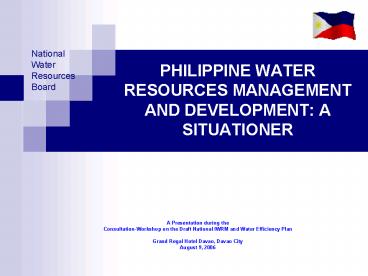PHILIPPINE WATER RESOURCES MANAGEMENT AND DEVELOPMENT: A SITUATIONER - PowerPoint PPT Presentation
1 / 18
Title:
PHILIPPINE WATER RESOURCES MANAGEMENT AND DEVELOPMENT: A SITUATIONER
Description:
4. Agno- Central Luzon (5,972 sq. km.) 5. Pampanga- Central Luzon (9.759 sq. km.) 6. Pasig-Laguna Bay- Southern Luzon (4,678 sq. km) 7. Bicol- Bicol (3,771 sq. km) ... – PowerPoint PPT presentation
Number of Views:3940
Avg rating:5.0/5.0
Title: PHILIPPINE WATER RESOURCES MANAGEMENT AND DEVELOPMENT: A SITUATIONER
1
PHILIPPINE WATER RESOURCES MANAGEMENT AND
DEVELOPMENT A SITUATIONER
A Presentation during the Consultation-Workshop
on the Draft National IWRM and Water Efficiency
Plan Grand Regal Hotel Davao, Davao City August
9, 2006
2
Water Resources Situationer
- Land area 300,000 km2
- Rivers and lakes occupy 1,830 km2
- Bays and Coastal Waters cover an area of
266,000 km2 - Annual Average rainfall 2,400 mm
- 12 Water Resources Regions based on hydrological
boundaries
3
Water Resources Situationer
- Surface water dependable supply
- - 125,790 MCM (80 dependability)
- Groundwater potential - 20,200 MCM (safe
yield)
- Total dependable water supply -
- 145,990 MCM
- 421 principal river basins
- - 18 are major river basins (DA ? 1,400 Km2)
4
Major river basins of the country 1. Abra-
Ilocos (5,125 sq. km.) 2. Cagayan- Cagayan Valley
(25,649 sq. km.) 3. Abulug- Cagayan Valley (3,372
sq. km.) 4. Agno- Central Luzon (5,972 sq.
km.) 5. Pampanga- Central Luzon (9.759 sq.
km.) 6. Pasig-Laguna Bay- Southern Luzon (4,678
sq. km) 7. Bicol- Bicol (3,771 sq. km) 8. Panay-
Western Visayas (1,843 sq. km.) 9. Jalaur-
Western Visayas (1,503 sq. km.) 10. Ilog
Hilabangan- Western Visayas (1,945 sq. km.) 11.
Agusan- Northern Mindanao (10,921 sq. km.) 12.
Tagoloan- Northern Mindanao (1,704 sq. km.) 13.
Cagayan de Oro- Northern Mindanao (1,521 sq.
km.) 14. Tagum-Libuganon- Southeastern Mindanao
(3,064) 15. Davao- Southeastern Mindanao (1,623
sq. km.) 16. Buayan-Malungon- Southeastern
Mindanao (1.434) 17. Agus- Southern Mindanao
(1,890 sq. km.) 18. Mindanao- Southern Mindanao
(23,169 sq, km.)
5
Water Potential and Demand by River Basin
Source JICA Master Plan Study on Water Resources
Management in the Philippines (1998). Low
economic growth scenario, 80 percent surface
water availability
6
HARD FACTS (Philippines)
- 9 major cities are at risk /vulnerable to
experiencing significant water constraints
(Master Plan 1998). - 18 river systems are below water quality
standards (Philippine Environment Monitor 2003). - 50 rivers (12) of the 421 rivers in the country
are considered biologically dead (Phil.
Environment Monitor 2003).
7
HARD FACTS (Philippines)
- Only a third or 36 of the countrys river
systems are classified as sources of public
water supply (Phil. Environment Monitor 2003). - Up to 58 of groundwater sampled is contaminated
with coliform and needs treatment (Phil.
Environment Monitor 2003). - Many areas experience a shortage of water supply
during the dry season - Per capita water availability is 1,907 cu.meter
per year ( second lowest in Southeast Asian)
8
Water Availability Per Capita by Major River
Basins
9
HARD FACTS (Philippines)
- Economic losses due to water pollutionPhil.
Environment Monitor 2003 - Estimated annual losses due to water borne
diseases is P3.3 B. - Annual average losses due to degradation of
fisheries environment is estimated at P17 B. - Economic losses to tourism is P47 B.
10
Issues and Concerns
- Declining Water Quality
- Rapid urbanization and industrialization
- Indiscriminate land use and development
- Increasing volume of solid wastes, pollutants and
hazardous wastes - Unabated extraction of groundwater
- Inadequate Sewerage and Sanitation facilities
- Watershed degradation
- Deteriorating health of river and coastal
systems
11
Water Quality Hot Spots in the Philippines
Source Philippine Environment Monitor 2003
12
Water Resources Assessment for Critical Areas
(Metro Cebu)
Source Water Resources Assessment for
Prioritized Critical Areas. NWRB.
2004
13
Water Resources Assessment for Critical Areas
(Metro Manila)
Source Water Resources Assessment for
Prioritized Critical Areas. NWRB.
2004
14
Key Issues and Concerns
- Increasing incidence and intensity of water
related risks such as Typhoons, Floods,
Droughts and Landslides
15
Key Issues and Concerns
- Fragmented and sectoral approach
- Numerous NGAs/institutions working on water
resources management - Lack of coherence in assigning water related
functions and accountabilities to national
government agencies - Unclear linkages among water-related national
government agencies, and between various levels
of government - Perceived overlapping and unclear mandates and
accountabilities relative to water resource
management and development
16
Functional Chart of Water Related Agencies
(Philippines)
EOHO
PAWB
Agency involve in water supply as coordinator
17
Key Issues and Concerns
Policy evaporation of strategic water related
issuances Weak and inconsistent enforcement of
water-related laws, rules and regulations Absenc
e of sufficient monitoring and tracking
mechanisms Low awareness among LGU leaders of
the urgency and developmental impacts of
effective water resource management and
responsive water governance
18
WATER IS EVERYBODYS CONCERN WE SHOULD WORK
TOGETHER TO EFFECTIVELY MANAGE AND PROTECT OUR
WATER RESOURCES FOR THE PRESENT AND FUTURE
GENERATIONS































